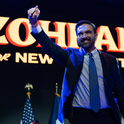Donald Trump’s fans have long worn something that visibly shows their support; the Maga hat is the most famous political accessory of the 21st century. But after Trump was nearly assassinated last week, with two others injured and one killed by a stray bullet, something has changed.
I was raised Catholic, and studied hagiography and iconography in western Europe during my university years. When I saw delegates at the Republican National Convention this week sporting bandages on their ears, my mind did not fly to thoughts of dispassionate political solidarity or parasocial fandom but to the imitation of Christ—the practice of following in his example—and to the endless rumination on his suffering that spectacles of faith demanded from religious publics during the Counter-Reformation, and which made them even more fervent. I’m not saying Trump is, or his supporters are, suddenly Catholic; he’s a non-denominational Christian who released a Bible this year which the Guardian called a “Christian nationalist’s fantasy”, and which was full of flags and bald eagles. But what I am considering is the level of devotion and iconography that is now made for, and by, the former president and convicted felon.
In the 16th and early 17th centuries, in the face of iconoclastic Protestant threat, Catholic worshippers were urged to contemplate weeping Virgins and ever bloodier Jesuses, and the martyr saints who were tortured to death for their love of God reached their height in popularity. While the Trump supporters who chose to wear the ear bandage likely didn’t self-flagellate their ears, they could have just worn a Maga hat to show their support; why did they want to imitate his wounds?
Some have dismissed it as a joke; RNC delegate Joe Neglia, who used a piece of paper over his ear, at first told Slate he was “starting a new fashion trend.” But when he expanded on his reasoning, the meaning of the faux-bandage also grew. To Fox News, he said “What can I do to honour the truth? What can I possibly do? And then I saw the bandage and I thought, I can do that. So, I put it on simply to honour Trump and to express sympathy with him and unity with him.” Another delegate, Ray Michaels, told the Associated Press: “We realised that this was a tragedy that should never have happened, and we want [Trump] to know that we are going through this with him.”
You will hear people call this cult behaviour, but this language is rarely useful because it’s too often used to diminish or disengage with ideas that people—normally other people and never us—have. It equally feels inadequate to describe this idolisation as secular when American politics references Christian politics so heavily. Trump’s speech last night suggested a lot more than simple political solidarity is at play here. He spoke of a “spirit” that forged America; a vision that is “righteous”, a cause that is “pure”, and “our shared and glorious destiny.” Those who counter his belief system are therefore trying to challenge unity, American destiny and what is fundamentally right—which obviously sounds an awful lot like dividing the world between the believers and non-believers.
While supporters demonstrated their faith in the crowd, Trump delivered a sermon from his pulpit. In Catholic art, martyrs who were killed for their devotion to God are depicted holding the weapons that led to their gory demises, or displaying their wounded bodies for increased scrutiny. St Lucy, the patron saint of blindness, is often shown holding a plate of her own eyes, which were gouged out by the pagan Roman authorities of her time. St Bartholomew similarly can often be seen holding his own flayed skin. Trump is wearing an ear bandage because he was wounded, not for stylistic purposes; but its unavoidable presence when you look at him is pure iconography, constantly reminding us of his survival, which to his ardent followers will feel like profound self-sacrifice.
Last night, we even saw a relic. In the early Catholic church, items like the bones of saints would be highly prized, venerated for their association with holiness and access to saintly intercession, which was understood to sometimes cause miracles. At one moment during his speech, Trump was halo-ed by half a dozen screens showing the immigration chart to which he turned to during the rally, saving his life. I would not be surprised if we see it heralded many more times during this campaign, like the Turin shroud.
A few days ago the New York Times ran a story on how Trump was an “incarnation of defiance”, drawing comparisons between his raised fist and the triumphant flag-bearing of Liberty in Eugène Delacroix’s “Liberty Leading the People”, an allegory of the French Revolution. It is one of the defining photographs of the attempted assassination, but at the Republican National Convention it was not the image that the former president chose when he relayed the events of last weekend for what he said would be the first and last time.
Instead, Trump chose an image taken by photojournalist Anna Moneymaker, who captured him pinned to the floor under the protection of the Secret Service, framed between the soles of an agent and with streaks of blood pouring down his face. A small glow of light peeps in from his top right, and his hand, likely fixed in fear, makes him look like he is praying. It is far more reminiscent of Ecce Homo than it is of a war painting, like that of the sculpture that sits in the Met in New York by Spanish sculptor Pedro de Mena. The icon, named after Pontius Pilate’s declaration—“Behold the man”—when he presented a scourged Jesus to the crowd before his crucifixion, often depicts Christ as bound, pallid and, most importantly, mortal. Blood oozes from his crown of thorns and drips down, just like it did from Trump’s ear wound.
In this Ecce Trump, the viewer is provoked to simultaneously feel horror and hope. If looked at as a devotional tool, as icons traditionally are, many will pause, ruminate and transport themselves to the moment the bullet grazed his ear and his life flashed before him. The former president likely knew this mimesis would be powerful, and so showed it to the crowd. In medieval art, text from the Bible may also be displayed alongside the image, but at the convention, we had Trump’s own words: “Blood was pouring everywhere and yet, in a certain way, I felt very safe because I had God on my side. I felt that.”
Trump the Redeemer gave many of his voters hope yesterday, telling them that he could “stop wars with just a telephone call”, but that hope did not come without caveat. The holy triumvirate, after all, doesn’t only have Jesus in it, but a God that spent a lot of the Old Testament smiting people. Christ wished peace to his brethren after his resurrection; Trump raised his arm and shouted, “Fight, fight, fight.”













